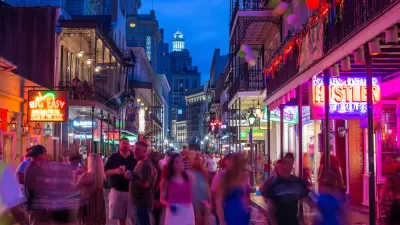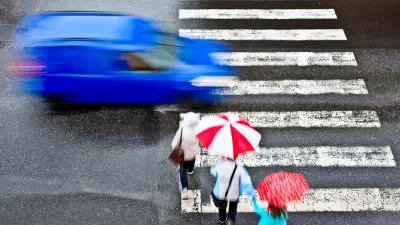New Orleans is experiencing a crime wave. High murder rates in the first two months of 2007 have made national attention. Anderson Cooper of CNN has been following this story. So far this year he has devoted two hour-long shows to this topic. I live in central New Orleans and my biggest complaint about the city is the high crime rate. I don’t think our city will recover if we fail to address this most serious issue. Crime makes you ask yourself – should I move to the suburbs where it’s safer and commute? But being a transportation planner, I can’t help but follow-up that question with – If I spend a lot more time driving will my exposure to dieing in a car accident increase? So which is worse - murder or traffic fatalities?
New Orleans is experiencing a crime wave. High murder rates in the first two months of 2007 have made national attention. Anderson Cooper of CNN has been following this story. So far this year he has devoted two hour-long shows to this topic. I live in central New Orleans and my biggest complaint about the city is the high crime rate. I don't think our city will recover if we fail to address this most serious issue. Crime makes you ask yourself – should I move to the suburbs where it's safer and commute? But being a transportation planner, I can't help but follow-up that question with – If I spend a lot more time driving will my exposure to dieing in a car accident increase? So which is worse - murder or traffic fatalities?
This question implored me to look at murder and traffic fatality rates in New Orleans to see how we compare to other cities and suburbs. The National Center for Statistics and Analysis of the National Highway Traffic Safety Administration posts information on traffic fatalities and injuries on their website (http://www-nrd.nhtsa.dot.gov/departments/nrd-30/ncsa/STSI/USA%20WEB%20REPORT.HTM). The Federal Bureau of Investigation's Uniform Crime Reports lists all of the crime statistics (http://www.fbi.gov/ucr/ucr.htm). In looking at the data, I chose the parish/county as the unit of analysis because the City of New Orleans is also a parish in its geographic boundary. The most recent traffic fatality data is from 2005, but due to Katrina the records for that year are unusable. In 2004, New Orleans had 265 murders or about 57 homicides per 100,000 people. This, by the way, was one of the highest rates in America which was about ten times the national average.
In 2004, Orleans Parish had 77 traffic fatalities or about 17 per 100,000 people. In some of the suburban parishes, such as St. Tammany, the rate was 26 per 100,000 an in the more rural Tangipahoa Parish the rate was 42 per 100,000 people. When you explore traffic fatalities in other states it's common to find the lowest rates in urban counties (where crime tends to be highest), higher fatality rates in suburban counties, and the highest rates in rural counties (where population is lower).
Unfortunately, high crime rates in New Orleans overcompensate for its relatively low traffic fatality rate. When you add homicides and traffic fatalities together, the rate of 74 deaths (by murder or car accidents) is still higher than in most counties, except for some of the most rural counties where traffic fatality rates are high due to a small population. For example, the four traffic fatalities in Steele County, North Dakota represented a rate of 200 fatalities per 100,000 people.
Because I'm a biker and pedestrian, I also know that urban areas tend to be more dangerous for those of us not inside cars. A better index for "exposure to death" would also include the rate of bicyclists and pedestrians killed in addition to traffic fatalities (which usually just reports deaths that occur inside cars).
The question for planners and planning researchers is – how do we best measure all of this? Car and highway advocates would ensure that we normalize the data by vehicle miles traveled, not population. That would yield lower rates for rural and suburban areas. Those of us that research pedestrian and bicycle planning know how difficult it is to measure the "exposure of fatalities" for bicyclists and pedestrians. Usually, intersections with high volumes of pedestrians and bicycles have the highest number of accidents. Should we encourage no one to walk or ride a bike so we can reduce the number of accidents? Perhaps we should encourage more walking and bicycling so rates decrease. My colleague John Pucher from Rutgers continually reminds me that pedestrian and bicycle fatality and injury rates are much higher in the USA compared to European countries. Planning and transportation policies in America have created a transportation system where people drive at high speeds on highways and little has been invested to develop safer and more accessible pedestrian and bicycling infrastructure.
I do have one question for Anderson Cooper. Why do you cover high murder rates and seldom mention how unsafe our cities are for those driving, walking, or bicycling? I know the answer – it's the same concept as when I get scared when my plane takes off and I don't think twice about driving in a car – the fear of the spectacular. A plane crash and the murder of an innocent person are spectacular events. Unfortunately, the death of over 40,000 Americans each year in cars and the numerous deaths of pedestrians and bicyclists rarely make the news.
For the time being, I will continue to walk and ride my bike in New Orleans. I often wonder if a car or perhaps a stray bullet will hit me. I will be working on a project to study bicycle and pedestrian safety and urban design in New Orleans. I hope to do my part to make the transportation system safer so I hope my colleagues working on criminal justice do their part to lower the murder rate.

Trump Administration Could Effectively End Housing Voucher Program
Federal officials are eyeing major cuts to the Section 8 program that helps millions of low-income households pay rent.

Planetizen Federal Action Tracker
A weekly monitor of how Trump’s orders and actions are impacting planners and planning in America.

Ken Jennings Launches Transit Web Series
The Jeopardy champ wants you to ride public transit.

New Mexico Aging Department Commits to Helping Seniors Age ‘In Place’ and ‘Autonomously’ in New Draft Plan
As New Mexico’s population of seniors continues to grow, the state’s aging department is proposing expanded initiatives to help seniors maintain their autonomy while also supporting family caregivers.

USDOT Waters Down Self-Driving Car Regulations
The agency is reducing reporting requirements for autonomous vehicles and cars with self-driving features, prompting concern among safety advocates who say transparency is essential to the safe deployment of AV technology.

‘Minnesota Nice’ Isn’t so Nice When You Can’t Find a Place to Live
The Economic Development and Housing Challenge Program can help address the scourge of homelessness among Indigenous people.
Urban Design for Planners 1: Software Tools
This six-course series explores essential urban design concepts using open source software and equips planners with the tools they need to participate fully in the urban design process.
Planning for Universal Design
Learn the tools for implementing Universal Design in planning regulations.
Heyer Gruel & Associates PA
Ada County Highway District
Institute for Housing and Urban Development Studies (IHS)
City of Grandview
Harvard GSD Executive Education
Toledo-Lucas County Plan Commissions
Salt Lake City
NYU Wagner Graduate School of Public Service




























